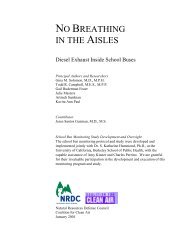US Nuclear Weapons in Europe - Natural Resources Defense Council
US Nuclear Weapons in Europe - Natural Resources Defense Council
US Nuclear Weapons in Europe - Natural Resources Defense Council
Create successful ePaper yourself
Turn your PDF publications into a flip-book with our unique Google optimized e-Paper software.
U.S. <strong>Nuclear</strong> <strong>Weapons</strong> <strong>in</strong> <strong>Europe</strong> • Hans M. Kristensen/<strong>Natural</strong> <strong>Resources</strong> <strong>Defense</strong> <strong>Council</strong>, 2005<br />
NATO ma<strong>in</strong>ta<strong>in</strong>s that these bombs are not aimed at any particular country. A June 2004<br />
NATO issue paper claims that the alliance has “term<strong>in</strong>ated the practice of ma<strong>in</strong>ta<strong>in</strong><strong>in</strong>g<br />
stand<strong>in</strong>g peacetime nuclear cont<strong>in</strong>gency plans and associated targets for its sub-strategic<br />
nuclear forces. As a result, NATO’s nuclear forces no longer target any country.” The<br />
statement is likely an exaggeration and slightly mislead<strong>in</strong>g. Although NATO no longer<br />
keeps aircraft on alert at the end of the runways as it did for most of the Cold War, it still<br />
ma<strong>in</strong>ta<strong>in</strong>s detailed nuclear strike plans for potential strikes aga<strong>in</strong>st specific targets <strong>in</strong><br />
specific countries. To justify further the presence of these weapons, NATO officials<br />
claim that the weapons are a deterrent to war, a theory disproved by the outbreak of<br />
armed conflict <strong>in</strong> Bosnia and Yugoslavia.<br />
Absent any mean<strong>in</strong>gful military role <strong>in</strong> <strong>Europe</strong>, nuclear planners have begun to search for<br />
political justifications for the nuclear weapons outside <strong>Europe</strong>. In the 1990s, U.S. and<br />
NATO officials heralded what they described as an unprecedented reduced role for<br />
nuclear weapons. At the same time, however, U.S. <strong>Europe</strong>an Command (EUCOM) and<br />
U.S. Strategic Command arranged for the potential use of the NATO nuclear bombs<br />
outside of EUCOM’s area of responsibility. <strong>Europe</strong>an parliaments may not be aware of<br />
this change and some of them probably would not support it.<br />
U.S. nuclear weapons <strong>in</strong> <strong>Europe</strong> undercut efforts to reduce global nuclear threat<br />
Not only are U.S. and <strong>Europe</strong>an rationales for forward-deploy<strong>in</strong>g U.S. nuclear weapons<br />
<strong>in</strong> <strong>Europe</strong> th<strong>in</strong>, but the presence of the weapons <strong>in</strong> <strong>Europe</strong> could affect the delicate<br />
relationship with other nuclear powers. Station<strong>in</strong>g U.S. nuclear weapons <strong>in</strong> <strong>Europe</strong><br />
undercuts efforts to improve relations with Russia and gives the Russian military an<br />
excuse to ma<strong>in</strong>ta<strong>in</strong> its own non-strategic nuclear weapons.<br />
Equally troublesome is the fact that NATO has earmarked nearly a third of the forwarddeployed<br />
weapons <strong>in</strong> <strong>Europe</strong> for use by the air forces of non-nuclear NATO countries, a<br />
violation of Non-Proliferation Treaty’s (NPT) ma<strong>in</strong> objective. Some claim that there is no<br />
NPT violation because the weapons rema<strong>in</strong> under U.S. custody until the U.S. president<br />
authorizes their use for war, at which time the treaty would no longer be <strong>in</strong> effect. But all<br />
preparation for the use of the weapons takes place now <strong>in</strong> peacetime. Equipp<strong>in</strong>g nonnuclear<br />
countries with the means to conduct preparations for nuclear warfare expresses a<br />
double standard that conflicts with U.S. and <strong>Europe</strong>an nuclear nonproliferation objectives<br />
to persuade countries such as Iran and North Korea from develop<strong>in</strong>g nuclear weapons.<br />
What should be done about U.S. nuclear weapons <strong>in</strong> <strong>Europe</strong>?<br />
To end Cold War nuclear plann<strong>in</strong>g <strong>in</strong> <strong>Europe</strong>, the United States should immediately<br />
withdraw the rema<strong>in</strong><strong>in</strong>g nuclear weapons from <strong>Europe</strong>. Do<strong>in</strong>g so would complete the<br />
withdrawal that began <strong>in</strong> 1991, free up resources <strong>in</strong> the U.S. Air Force and <strong>Europe</strong>an air<br />
forces for real-world non-nuclear missions, and enable NATO to focus on the nonnuclear<br />
security priorities that matter.<br />
In addition, NATO should end the practice of assign<strong>in</strong>g nuclear strike missions to nonnuclear<br />
member countries. This should <strong>in</strong>volve the removal of all mechanical and<br />
6
















